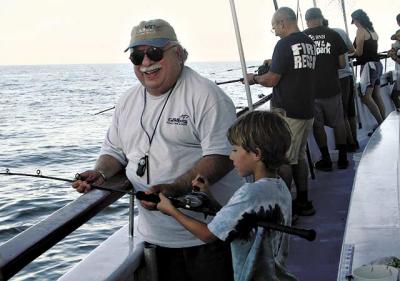It’s All About the Flow

Flow. It’s what we want, not hangs. I have a friend who moved way down south to a dirt-road town called Pavones. It’s located on the southeast side of the Sweet Gulf, Golfo Dulce, not far from the Panamanian border, where some of the finest waves in the world peel along the Costa Rican coastline. His name is Harry Abrams, but we call him Flowmaster.
Harry came to mind on Friday after I attended the opening of the “Surf Craft” installation at the LongHouse Reserve in East Hampton. The show is a curated collection of old and new surfboards, each chosen for its place in the unending quest for perfect flow on the face of a wave.
I thought a lot about Flowmaster recently because I’m working with a talented group of locals toward the opening of the Oceans Institute of the Montauk Lighthouse Museum. Our first installation features surfboards built by Long Island board builders in the mid-to-late-1960s.
The boards, shaped by Charlie Bunger, Bob Hawkins, Jack Hannon, Peter Lutz, and Jim Campbell, were based on shapes pioneered by West Coast board builders like Dale Velzy and Hap Jacobs, who in turn came up with their designs through the experience of wave riders going back to fishermen, explorers, and anyone else who used Nature’s pulse to push them toward terra firma. At one point, the thrilling flow of the journey became the goal. To hell with its end.
Harry Abrams surfed, smoked Camels, and shaped surfboards. Back in the ’60s, while working for Bunger Surfboards in Babylon, he became obsessed with the size and shape of skegs, the fins that give surfboards their stability, allow them to turn, and hold the face of a wave. His fins got longer and more flexible until they looked like the tails of thresher sharks. The idea was to create a surfboard that would snake down and along the face of a wave.
Flowmaster had gone down the rabbit hole in a sense. The fins never worked as well on a wave as they did in his head. We snickered, starting calling him Flowmaster as a rib, and yet he was on the right track. As time went on, fins did get longer, more flexible. Flowmaster doesn’t surf that much anymore. The Camels saw to that. But he still talks flow. The last time I saw him, in Pavones, he told me he was writing a surfing ballet to be performed onstage. Ridiculous? Just wait.
On Saturday, my old friend Louis Gippetti showed up in Montauk from his home in Massachusetts. Like me, Louis is a postwar product of Levittown who got into the world of surfboard riding, design, and building in the late ’60s. We sat on the beach and talked about those times, about Louis’s designs for a flexible surfboard — way out there. We laughed, but not hard. He told me that back then he’d sent one of his designs to George Greenough of Santa Barbara, surfboard designer extraordinaire. Looking back, it was sort of like sending, from out of the blue, a design for a new kind of house to Frank Lloyd Wright.
In return mail Louis received a drawing of a bolt of lightning scratching the sky above the sea. Louis observed that between the extremes of design lies a vast “gray area” to be explored. Louis bought a new surfboard on Monday designed by Mikey DeTemple, a professional longboard surfer who calls the East End home. No money changed hands until Louis and the salesman caressed every curve in the rails, the almost invisible concave toward the nose, the sweet, subtle rocker in the tail “that holds in the foam ball” of the wave for stable nose-riding. Their words flowed as though spoken in awe above a child just breached.
The LongHouse show features a whole section devoted to the designs and concepts of Bob Simmons, who experimented in the ’50s with “planing” surfaces that he translated into boards of balsa wood, and a section that features the same George Greenough who used kneeboards to find the “slot,” the perfect trim spot in a wave.
On Sunday, beautiful Sunday, Kyle and I awoke on Lake Montauk aboard our sailboat Leilani. Fish broke the mirror surface just after dawn, causing rain bait to take to the air.
Later, we took to the one-man outrigger canoe my daughter, Melissa, and I purchased last summer from a couple moving back home to New Zealand. While attending the University of Hawaii, Melissa joined an outrigger paddling team. Our canoe is 18 feet long and weighs just 22 pounds — fast, moves like greased lightning across the smooth water.
Melissa drove out from Springs to join us. “You lean into the ama,” she said, the Hawaiian name for outrigger. She told how her coach trained them by making the six-man canoe team extend the paddle with only the top hand as far forward as possible and grab it lower down with the other hand only when the flow of the canoe threatened to steal the paddle from them. This to increase the length of the stroke.
She took off like the proverbial bat, digging deep with the paddle, gleeful, almost desperate it seemed, to feel again the flow of a craft whose design evolved over hundreds if not thousands of years, and just two months after giving birth to my granddaughter.
And later the same day, I tied a second reef in the mainsail of Leilani, our Bristol 29.9, her hull designed by Halsey Herreschoff, grandson of the genius Capt. Nathaniel Herreschoff, to see if the smaller sail would balance better with the jib in the high, gusty winds we’ve been experiencing of late, to see if it would create a sweeter flow. It did.
